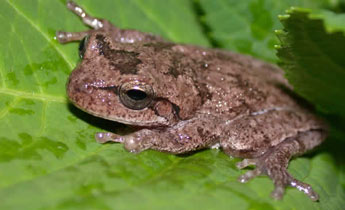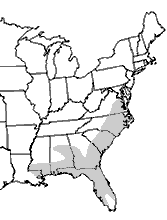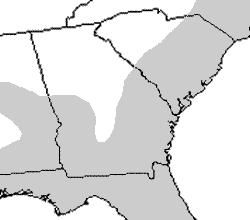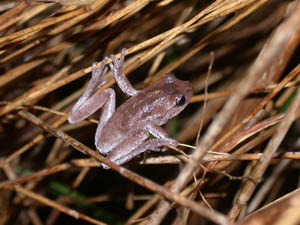Pine Woods Treefrog (Hyla femoralis)



Photos by J.D. Willson unless otherwise noted
Pine Woods Treefrog’s call
Description: The pine woods treefrog is a small frog that grows up to 1.25”. It is diminutive and slender in appearance similar to the squirrel treefrog, except that it has a row of small orange, yellow, or even whitish spots on the rear of the thigh that cannot be seen when the frog is at rest. This frog’s toes are only slightly webbed.
Range and Habitat: Pine woods treefrogs are found much of the southeast. They can be found in parts of far west as Louisiana north into Virginia, and as far south as Florida. They are normally found along forested areas in pine flatwoods and the adjacent habitats. They will breed in ephemeral wetlands, ditches, shallow swamps, and marches. They do no breed in habitats containing predatory fish.
Habits: Pine woods treefrogs can be found in large numbers at breeding locations and when migrating to these sites. During nonbreeding, they can be difficult to find as they prefer to spend their days hiding in trees. This species may also burrow in shallow, sandy soil or sometimes hide under tree bark. This species is nocturnal during the warmer spring and summer months. It is presumed that they stay dormant during the cooler months under logs and shallow burrows. Pine woods treefrogs begin courting in late March through early April and continue through the summer through early fall. Large choruses are typically heard after large rain events. Females lay up to 2,000 eggs which are deposited into smaller clusters of up to 100 eggs. Eggs are deposited in sticky clumps only one inch below the water. Eggs hatch in late spring to early summer into tadpoles. These tadpoles will metamorphosize into froglets between 1.5-2.5 months.
Call: The sporadic chattering call of the pine woods treefrog gives it the nickname “Morse-code frog.” It can be heard from April to October.
Conservation Status: Pine woods treefrogs can be found commonly in certain areas and not considered threatened.
Pertinent Reference:
Dorcas, M., and Gibbons, W. (2008). Frogs and toads of the Southeast. University of Georgia Press.
Account author: Katrina M. Ford

